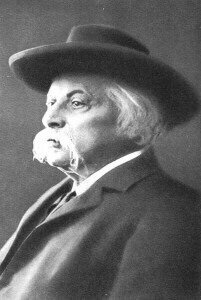 In ancient Greece, the coming of the New Year was celebrated by presenting a newborn baby to Dionysus, the God of Wine. Used as a symbol of rebirth, the newborn child also featured prominently in early Christian practices, and today it’s a race to the finish! Millions of expectant mothers in countless hospitals worldwide vie to deliver their offspring on the stroke of midnight. With the local press and cameras gathered, hospitals engage in serious competitions and promotions, with the winning newborn receiving gift certificates, car seats, brand new strollers and a guaranteed picture and story in the newspaper or television media. With all this media hoopla, it’s easy to forget that occasionally, people also pass away around that time of year. The Hungarian composer Karl Goldmark received his last rites on 1 January 1915—one hundred years ago—but since he was in no particular hurry, he peacefully died on 2 January 1915. And as it happens, he was promptly forgotten.
In ancient Greece, the coming of the New Year was celebrated by presenting a newborn baby to Dionysus, the God of Wine. Used as a symbol of rebirth, the newborn child also featured prominently in early Christian practices, and today it’s a race to the finish! Millions of expectant mothers in countless hospitals worldwide vie to deliver their offspring on the stroke of midnight. With the local press and cameras gathered, hospitals engage in serious competitions and promotions, with the winning newborn receiving gift certificates, car seats, brand new strollers and a guaranteed picture and story in the newspaper or television media. With all this media hoopla, it’s easy to forget that occasionally, people also pass away around that time of year. The Hungarian composer Karl Goldmark received his last rites on 1 January 1915—one hundred years ago—but since he was in no particular hurry, he peacefully died on 2 January 1915. And as it happens, he was promptly forgotten.
During his lifetime, Goldmark was one of the most popular and powerful composers in Vienna. Rubbing shoulders with Brahms and Mahler, and counting Jean Sibelius amongst his students, Goldmark was largely self-taught as a composer. His early works were not well received, but his opera Die Königin von Saba (The Queen of Sheba) became an instant success. First performed on 10 March 1875 in Vienna, the work proved so popular that it continuously remained in the repertory of the Vienna Opera until 1938. In fact, the work became the composer’s calling card and was followed in quick succession by an additional five operas. However, it was his Ländliche Hochzeit (Rustic Wedding Symphony) of 1875 that eventually caught the attention of Sir Thomas Beecham and Leonard Bernstein. A vividly atmospheric symphonic poem, it unfolds in five suite movements including a wedding march, a nuptial song, a serenade, a tender dialogue between the bride and groom in a garden, and a concluding dance movement. At the time of its premiere, Johannes Brahms, whose own first symphony had not yet received its first performance, commented: “It’s the best thing you have done; clear-cut and faultless.” And as it happens, it was promptly forgotten.
Today, the most frequently performed and recorded composition by Karl Goldmark is the Violin Concerto No. 1 in A-minor, Op. 28. Composed in 1877, the work was first performed in Bremen and enjoyed great popularity. Goldmark was a violinist by training and also a skilled orchestrator, with both qualities contributing to an effective balance between solo and tutti passages. The opening movement presents a finely wrought Hungarian march, and his natural gift for lyrical melodies emerges most prominently in passages reminiscent of Dvořák and Mendelssohn in the second and third movements. Nathan Milstein, Itzhak Perlman and Joshua Bell have championed the concerto, but it has not found a permanent place on the concert stage. For one reason or another, Karl Goldmark and his compositions were seemingly destined to be forgotten. Asked what he did for a living by an old lady with whom he found himself traveling, Karl Goldmark (1830-1915) is said to have answered, “I am a composer—I am the composer of The Queen of Sheba.” “Ah yes,” the lady responded, “and does the post pay well?” If only he could have been born on January 1st, things might have worked out differently!
Karl Goldmark: Violin Concerto No. 1 in A-minor, Op. 28
More Anecdotes
- Bach Babies in Music
Regina Susanna Bach (1742-1809) Learn about Bach's youngest surviving child - Bach Babies in Music
Johanna Carolina Bach (1737-81) Discover how family and crisis intersected in Bach's world - Bach Babies in Music
Johann Christian Bach (1735-1782) From Soho to the royal court: Johann Christian Bach's London success story - A Tour of Boston, 1924
Vernon Duke’s Homage to Boston Listen to pianist Scott Dunn bring this musical postcard to life
